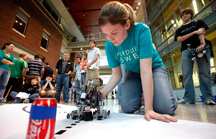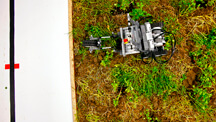
| RELATED INFO |
| * Zero-gravity drop tower |

June 16, 2009
New engineering lab enhances student success in its first year
WEST LAFAYETTE, Ind. - |
During the two semesters the Ideas to Innovation Learning Laboratory (I2I) has been open, attendance for first-year engineering students jumped almost 20 percentage points to 98 percent. And the number of students withdrawing or earning non-passing grades fell from 10 percent to 5 percent.
"Though there are many factors that play a role in student performance, the I2I can be considered a major reason for the change in retention indicators from the previous year's class," said Teri Reed-Rhoads, assistant dean of undergraduate engineering and associate professor of engineering education. "We offered the same content, the same instructors and the same grading requirements, but all in a modern learning environment that was designed based on educational research."
With the learning lab and its companion classroom, what had been a 450-student, first-year lecture class are now 120-student classes. Those classes are then broken down into teams that work on projects.
"Previously, the first-year students were given projects, but they didn't have I2I and its technology," Reed-Rhoads said. "They would end up working on the projects in their rooms, and that didn't encourage a team approach."
The I2I has seven studios where students can work on different functions as they take a project from idea to completion. They are the Design Studio, Demonstration Studio, Prototyping Studio, Electronics Studio, Fabrication and Artisan Laboratories, and Innovation Studio.
 |
One class project this year came from Boiler Green Initiative, a student organization that is developing a "green" roof for one of the campus buildings. The assignment was to design a robot that could successfully navigate a path on the roof's irregular surface to collect biological data about insect diversity.
The students got a real-world project and Boiler Green Initiative got a look at whether such a robot might be feasible.
The project also is just the type of work that the School of Engineering Education wants its beginning engineers working on in I2I.
"The College of Engineering is focused on educating engineers who can work on the global challenges that society faces now and into the future, like the environment," Reed-Rhoads said.
She said that while other engineering schools have learning labs for beginning students, Purdue's is unusual in that it combines both a classroom studio and the design studios.
"You also might expect to see facilities like this in a smaller school, certainly not at an engineering school as big as Purdue's."
About 1,700 students were in the 2008-09 first-year engineering class.
While the 2009-10 first-year engineering class won't be on campus until late August, the I2I won't go unused. This summer three groups of rising high school seniors who are considered top engineering prospects will spend time in the I2I, as will two Women in Engineering camp groups and elementary teachers on campus for summer programs.
The I2I joins several other high-tech facilities used by students studying engineering, science and technology at Purdue. Among the others are:
* A small nuclear reactor used to educate nuclear engineering students. Purdue enrolls more nuclear engineering students than any other university in the nation. The hands-on experience solidifies theory learned in the classroom with actual practice.
* The Robert L. and Terry L. Bowen Laboratory for Large-Scale Civil Engineering Research. The lab attracts top engineering faculty and students who want to conduct large-scale research. Five other U.S. universities have similar facilities, but none is as modern as the Bowen Laboratory.
* The Maurice J. Zucrow Laboratories, a complex housing research into rocket propulsion, jet engines and hydrogen storage for future cars. In the High Pressure Laboratory, one of six Zucrow facilities, students learn about and conduct experiments with rocket engines. Researchers use the facility for work sponsored by NASA, the Army and Air Force, other federal agencies, and aerospace companies. Few universities in the world possess a similar rocket-testing facility.
* A zero-gravity "drop tower," one of only three of its kind and the most modern in existence. Purdue has one of two programs in the nation where students can take a class in zero-gravity experiments, often flying their experiments on a special NASA airplane. The students take a project from conception to execution while meeting NASA's rigorous technical standards.
* The Purdue Rare Isotope Measurement Laboratory, or PRIME Lab. It houses a tandem electrostatic accelerator used for accelerator mass spectrometry. Students use the equipment to study low levels of radionuclides and rare trace elements. Purdue is the only university in the nation with an accelerator mass spectrometer powerful enough to perform tests on very low levels of trace elements, such as the test used to determine the age of "Peking Man."
* The Birck Nanotechnology Center cleanroom. The Scifres Nanofabrication Laboratory cleanroom has high-end equipment to advance research at the nanoscale level and design the next generation of electronic devices.
* Purdue's Interdepartmental Nuclear Magnetic Resonance (NMR) facility. Students work with spectrometers to examine molecules such as proteins and metabolites.
Writer: Judith Barra Austin, 765-494-2432, jbaustin@purdue.edu
Source: Teri Reed-Rhoads, 765-494-4966, trhoads@purdue.edu
Purdue News Service: (765) 494-2096; purduenews@purdue.edu
PHOTO CAPTION:
Jessie Powell redirects her team's robot as it tries to follow a line on its way to lifting a weighted aluminum can. First-year engineering students spent a semester building robots designed to collect insect data on a new green roof planned by Boiler Green Initiative. (Purdue University photo/Andrew Hancock)
A publication-quality photo is available at https://www.purdue.edu/uns/images/+2009/boiler-green-robots1.jpg
PHOTO CAPTION:
A robot built by students for an assignment from the Boiler Green Initiative navigates its way into a simulated portion of a green roof to be evaluated. (Purdue University photo/Andrew Hancock)
A publication-quality photo is available at https://www.purdue.edu/uns/images/+2009/boiler-green-robots2.jpg
To the News Service home page
